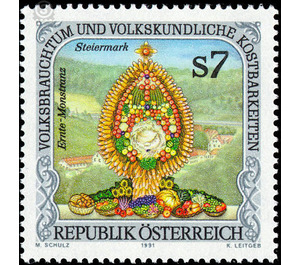folklore - Austria / II. Republic of Austria 1991 - 5 Shilling
Theme: Art & Culture
| Country | Austria / II. Republic of Austria |
| Issue Date | 1991 |
| Face Value | 5.00 |
| Color | multi-colored grey |
| Printing Type | combination printing |
| Stamp Type | Commemorative |
| Item Type | Stamp |
| Chronological Issue Number | 1385 |
| Chronological Chapter | OOS-OE2 |
| SID | 647164 |
| In 58 Wishlists | |
Sowing, fertility and Erntebrauchtum roots in pre-Christian times. At the end of the 19th century, the first evidence of pronounced Christian-religious harvesting can be found in our latitudes. Under Joseph II, the 2nd Sunday in October was set as Kirchweihsonntag. This feast day is still celebrated today with thanksgiving services: the churches are adorned and a whole series of offerings are offered. These are the most diverse structures, such. Wreaths, crowns or monstrances put together. The earliest report of a harvest monstrance is handed down from the parish of St. Stefan ob Stainz from 1892. The monstrances, made of a wooden base, decorated with fruits and grains, are illustrative works of folk art that testify to the pious reverence in Christian-religious customs.


